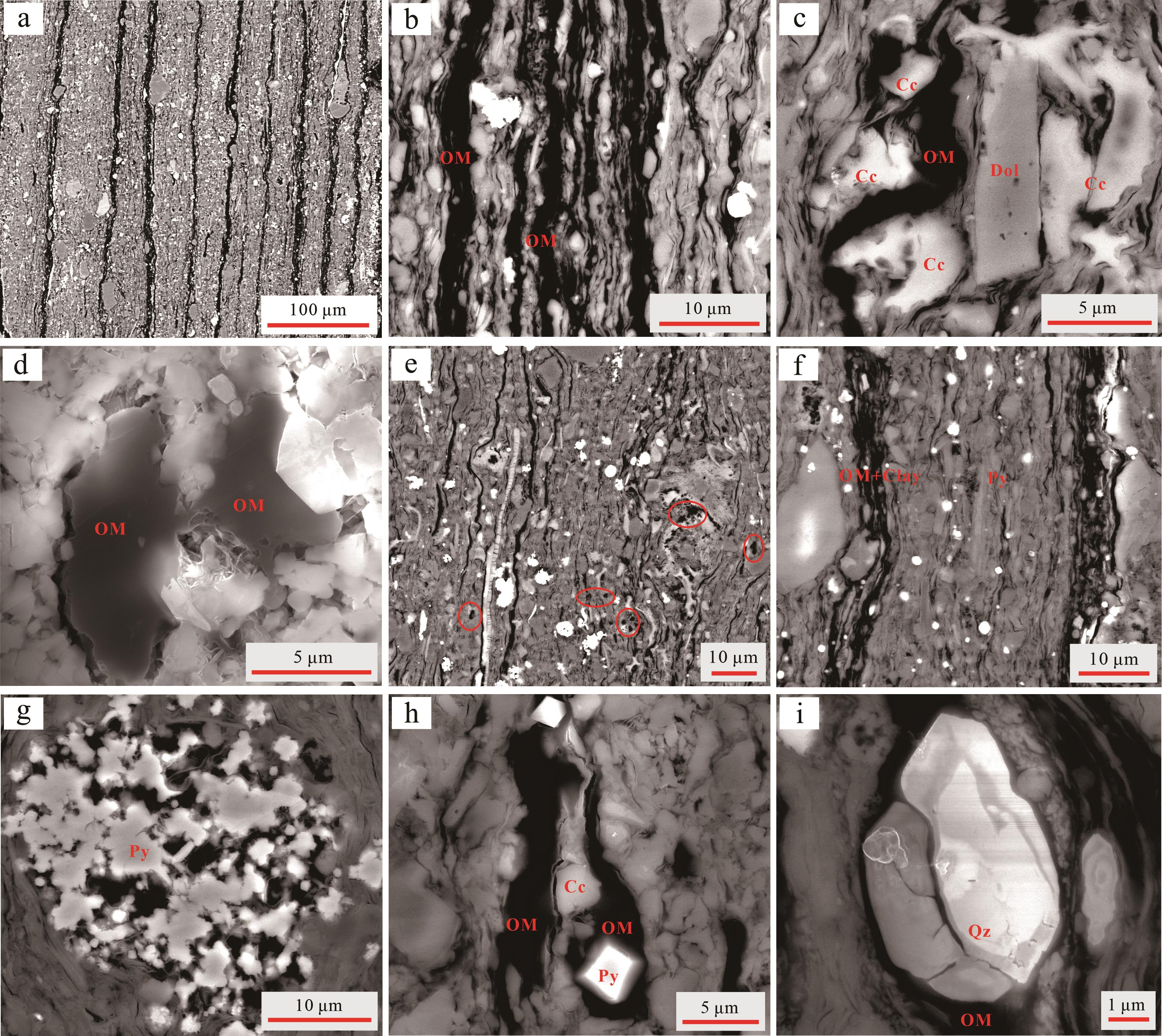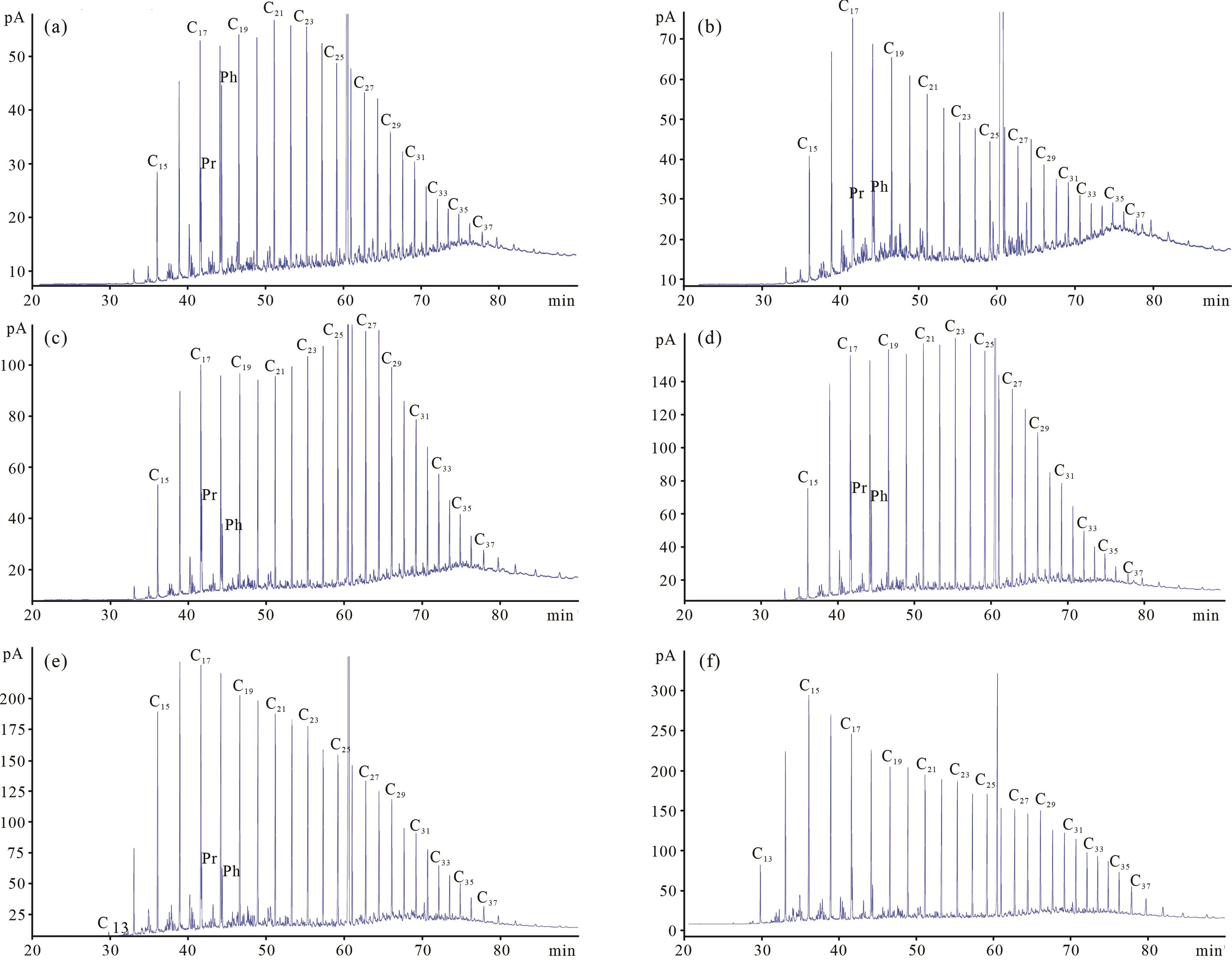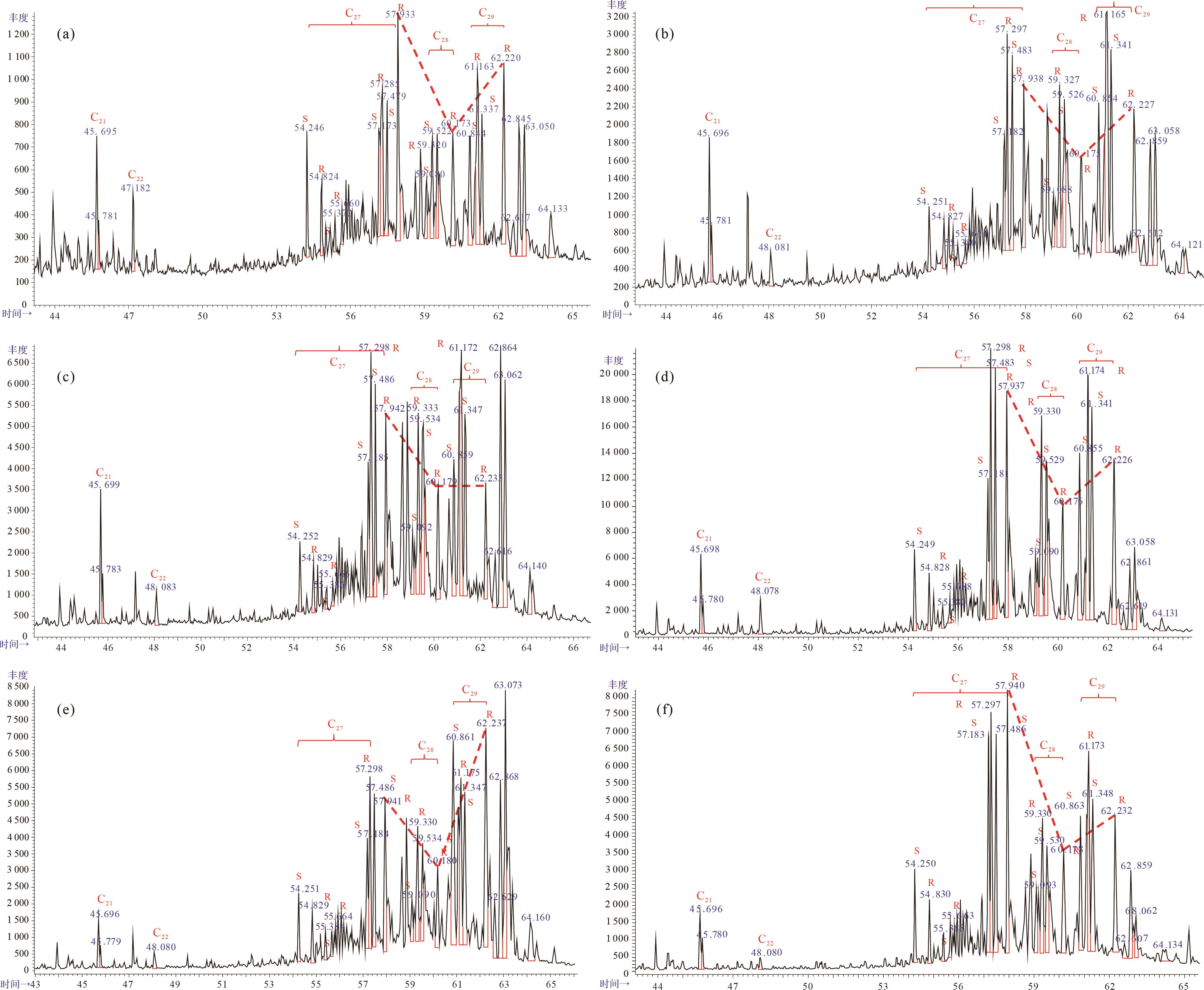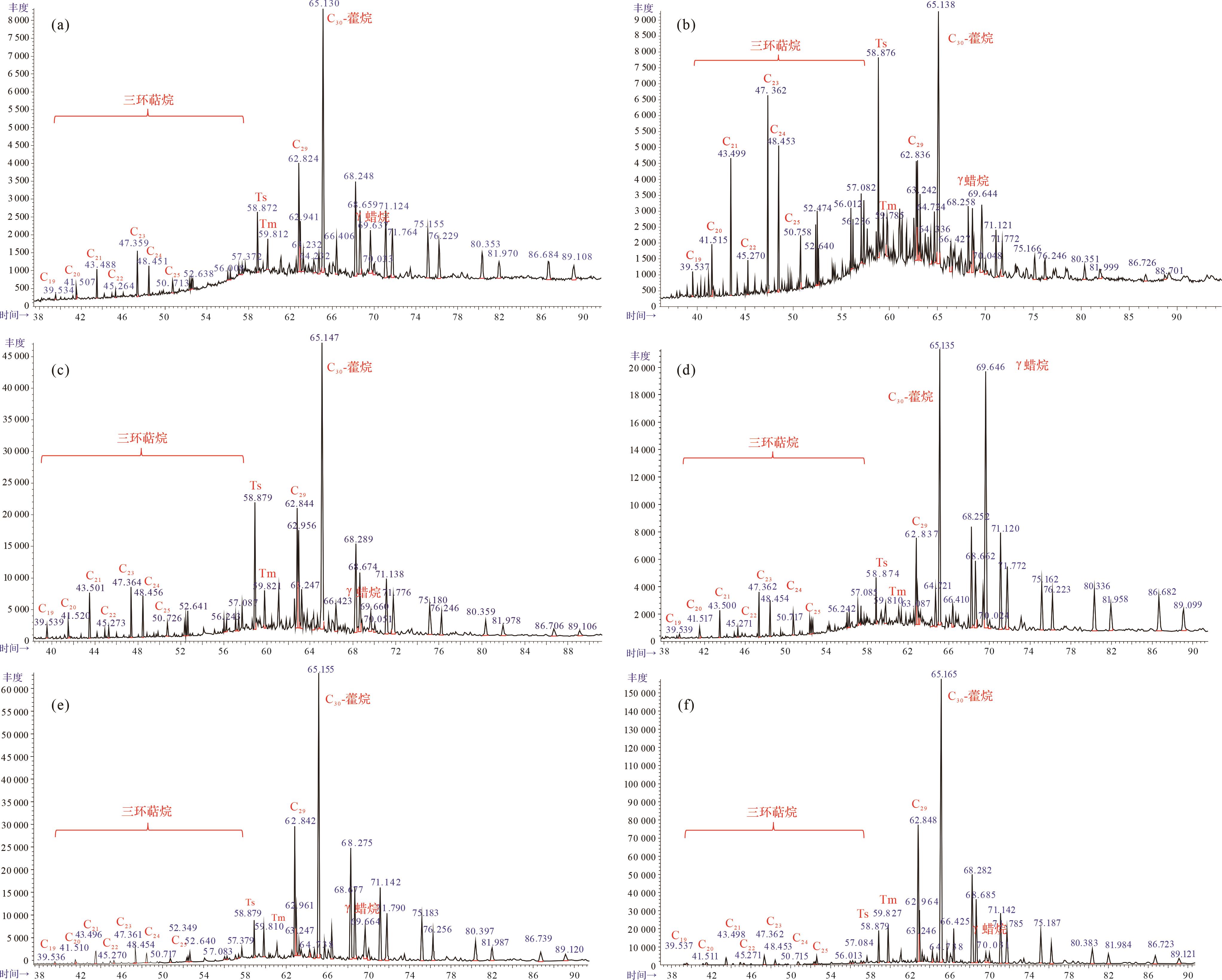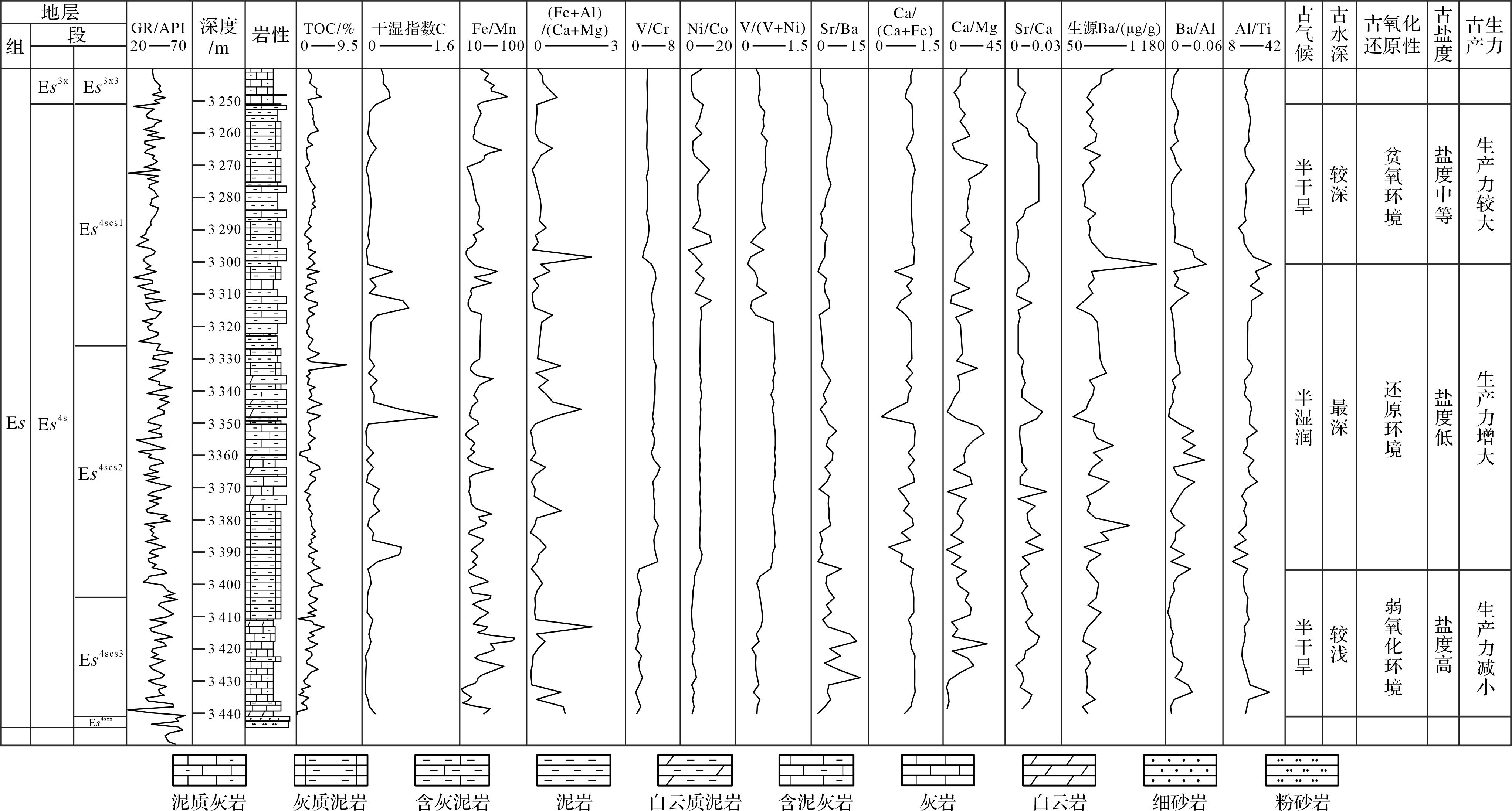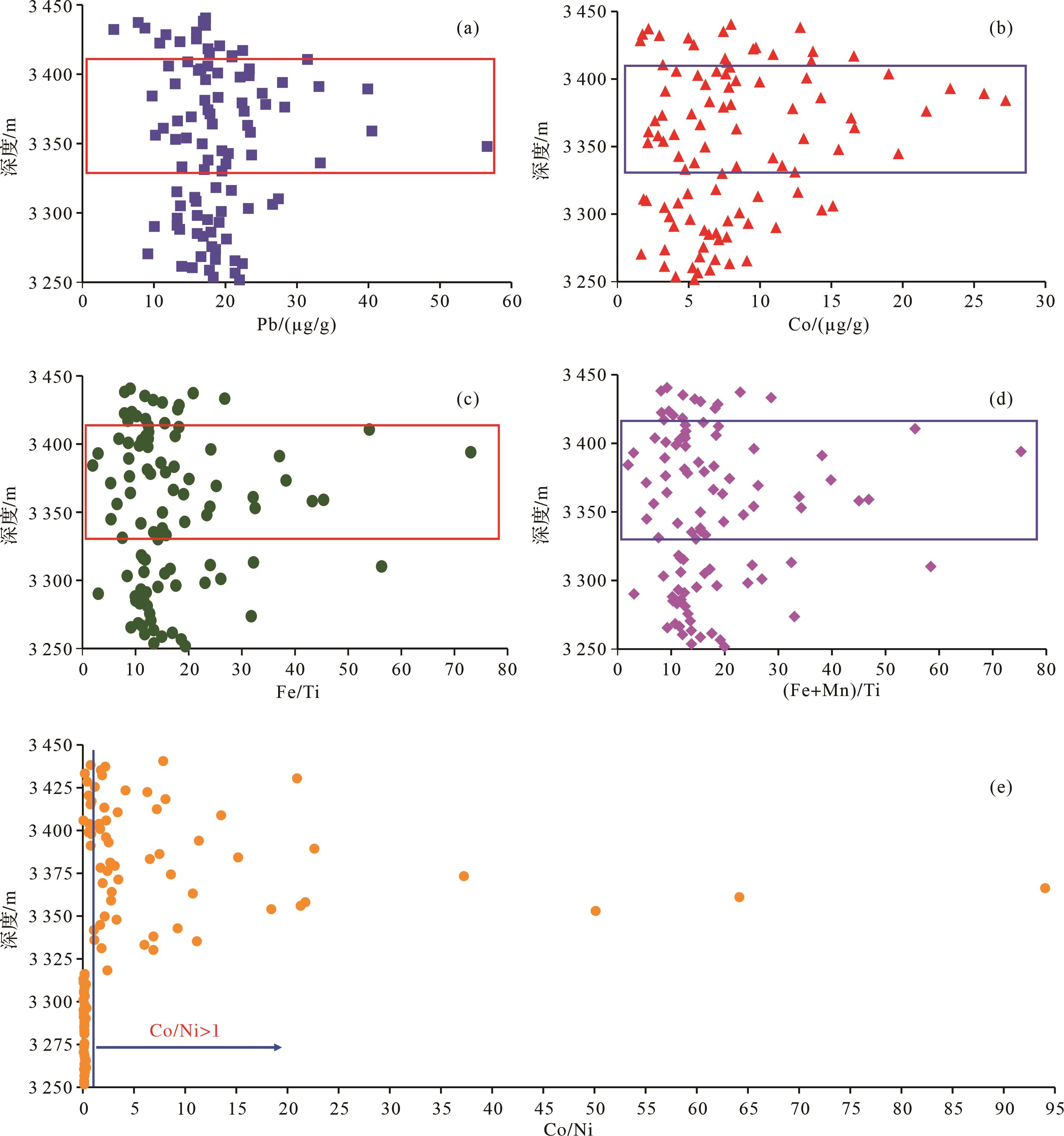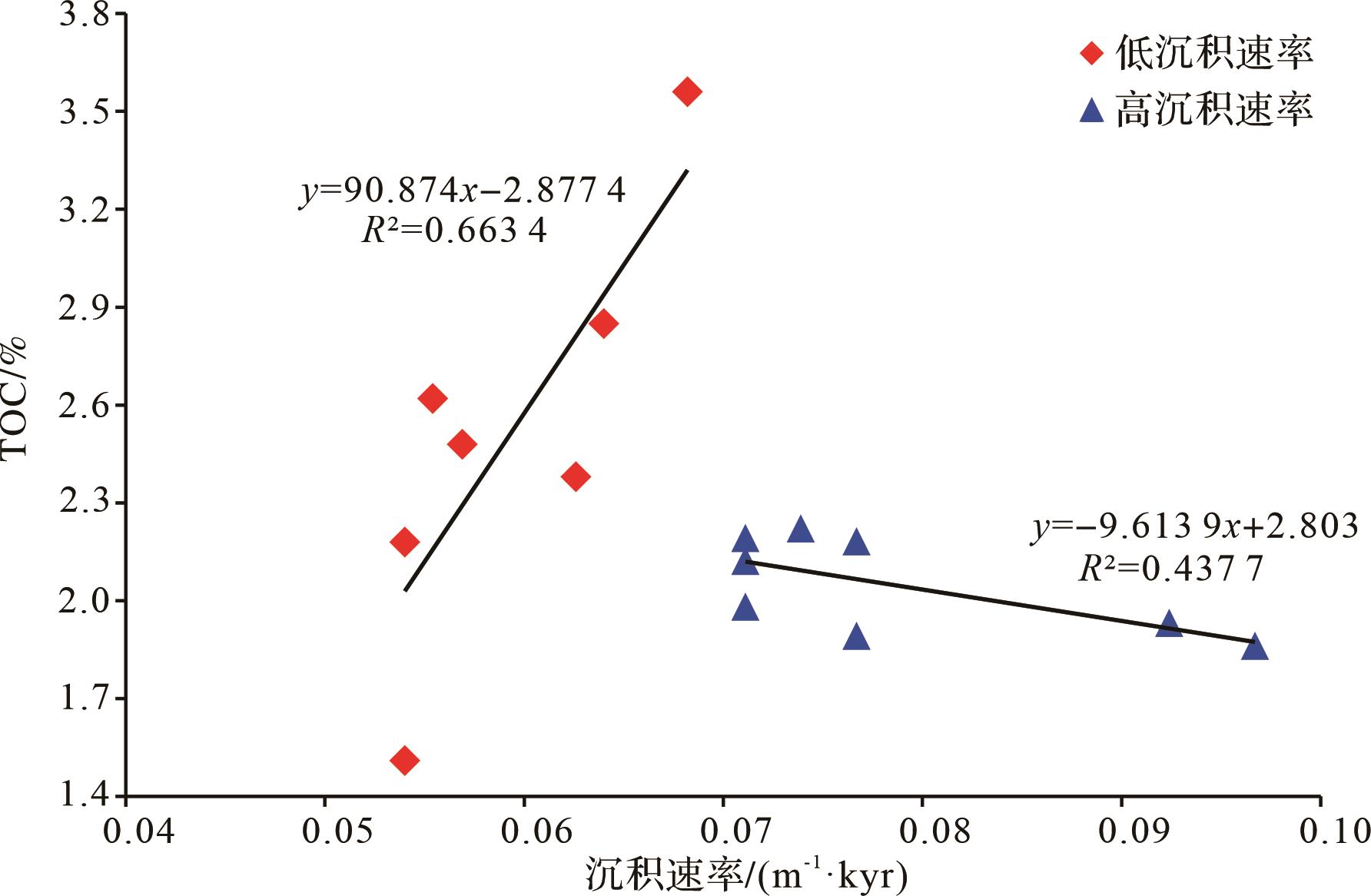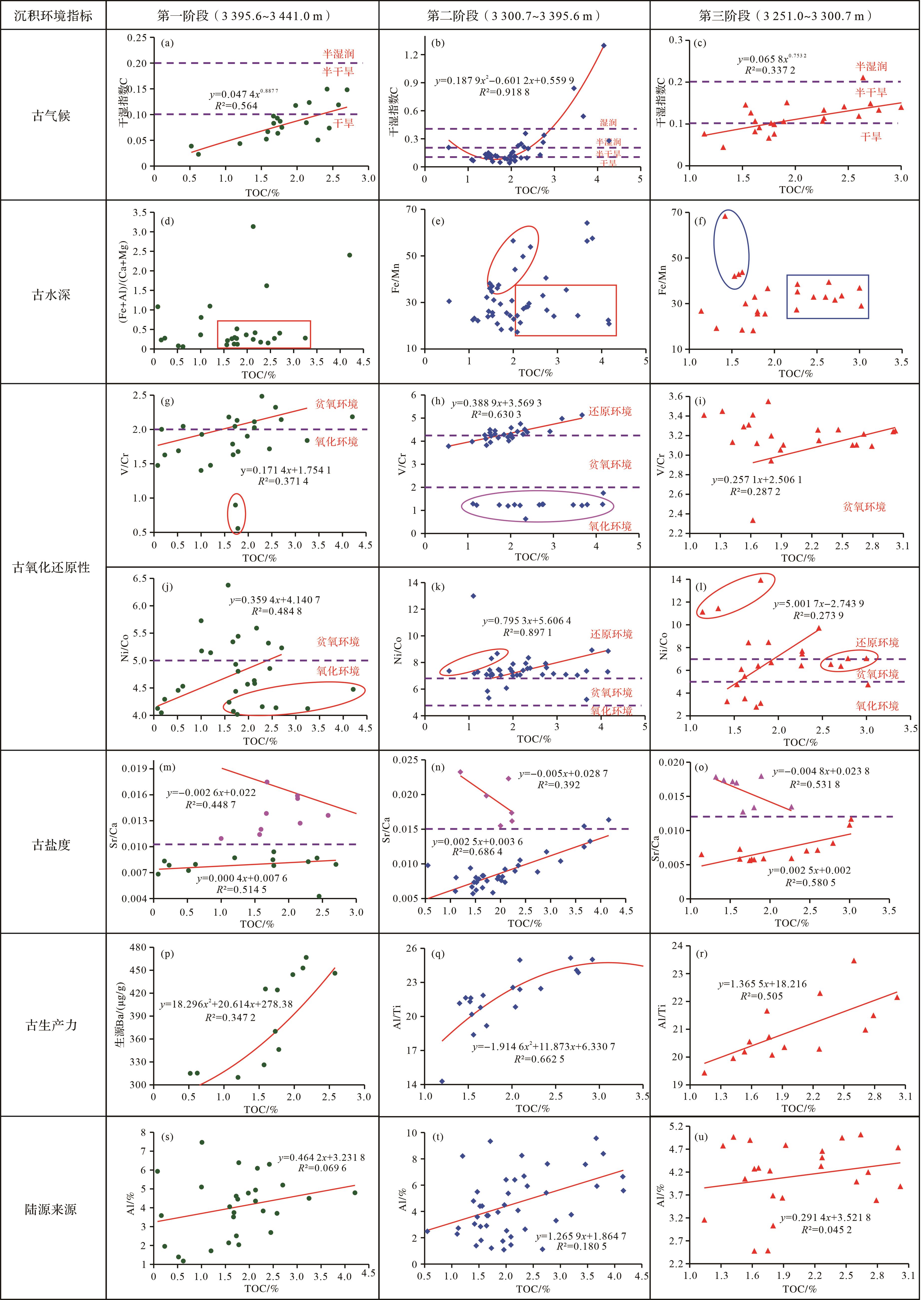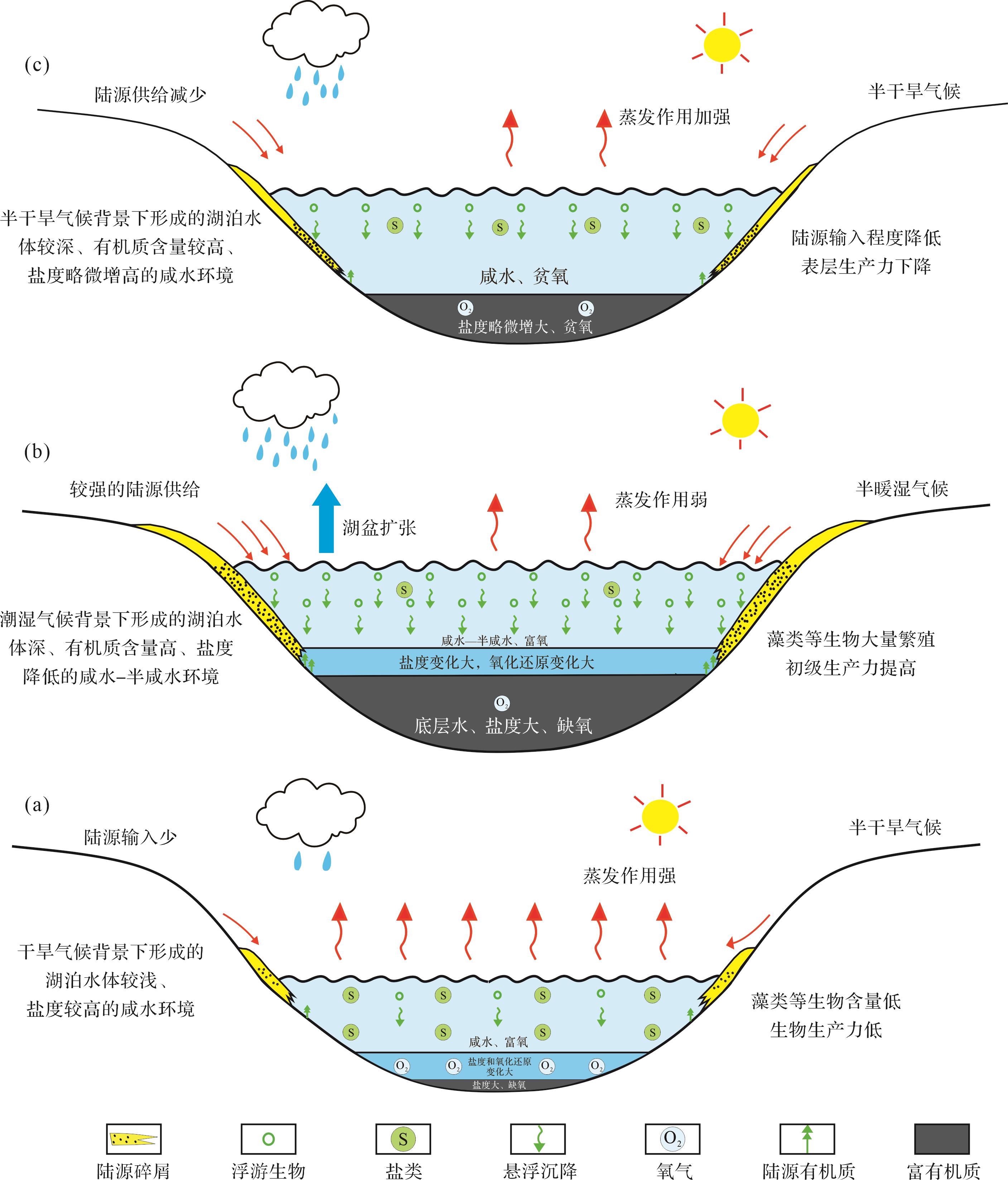HTML
-
近年来,有机质沉积物富集的影响因素一直是讨论的热点,尤其是陆相断陷湖盆有机质形成条件及其富集机理研究是非常规油气勘探研究的重点[1⁃2]。但由于湖相烃源岩沉积过程中更容易受气候影响,造成有机质富集特征更为复杂、非均质性更强[3⁃5],加之受限于测试分析资料等,导致目前对湖相咸水断陷湖盆沉积环境下形成的东营凹陷沙河街组烃源岩认识较浅,而有学者认为有机质的富集受陆源输入、初级生产力及保存条件等因素的影响,但尚不清楚优质烃源岩的形成条件,故有机质影响机理及富集模式亟需进一步探究[6]。
影响有机质聚集的因素较多,包括生产力、氧化还原性、沉积速率及沉积后的降解过程等[7⁃12]。前人针对泥页岩有机质富集已开展了大量研究,其研究成果可以归纳为以下几种学术观点:生产力学派主要以Sageman et al.[13]和Gallego-Torres et al.[14]为代表,认为有机质富集主要受控于海洋表层的生物生产力,水体氧化还原性质影响有限[15⁃17];氧化还原学派主要以Mort et al.[18]为代表,认为当水体的氧化还原性为缺氧环境甚至达到硫化环境时,在海洋表层生产力较低的情况下也可形成有机质含量高的沉积物[19];沉积速率主导的学派以Murphy et al.[20]为代表,他们认为当沉积速率处于适当水平时会促进有机质富集,但是当沉积速率过高或者过低时均不利于有机质富集[21⁃23];以吴诗情等[24]、丁江辉等[25]、久凯等[26]、夏威等[27]、梁钰等[28]为代表的学者认为海底热液活动为富有机质页岩提供了必要的物质基础和保存条件;以李登华等[29]、吴蓝宇等[30]、卢贤志等[31]、梁新平等[32]、王书荣等[33]、李森等[34]为代表的学者认为火山活动释放的火山灰不仅可以提供营养物质,与火山活动有关的缺氧环境还为有机碳保存创造了有利条件。目前,对有机质富集的研究仍然主要集中在海相盆地,而国内页岩油气丰富且主要赋存于陆相断陷湖盆[35⁃38],但由于该类型的湖盆面积小、水体浅、湖平面变化频繁,且较易受构造和沉积环境的影响[39⁃40],使得有机质来源、富集控制因素及富集机制与海相有较大差异,故需加强对湖相沉积有机质富集机制的研究,建立合理的有机质富集模式。
东营凹陷古近系沙河街组发育数百米厚的富有机质细粒沉积岩,该凹陷油气资源丰富,勘探程度高,沉积学及地球化学等测试分析数据丰富,是开展细粒沉积有机质富集特征、富集控制因素及富集模式研究的最佳地区。针对研究区富有机质页岩层段,前人在岩性岩相特征、储集空间、沉积环境等方面开展了大量研究,但受到测试资料不足等限制而对有机质形成机理研究较少,且有机质的富集控制因素和富集模式尚不明确。基于此,选取东营凹陷系统取心井FY1井、NY1井、LY1井和GX27井沙河街组第沙四段上亚段纯上次亚段富有机质细粒沉积岩作为研究对象,开展矿物学、有机地球化学、元素地球化学、生物标志化合物和孢粉鉴定等分析,详细阐述有机质富集特征及来源,在分析湖盆沉积环境演化阶段的基础上,分阶段分析表征沉积环境、陆源碎屑、沉积速率等各指标与有机质发育的相关关系,探讨有机质富集的主控因素,最终建立有机质富集模式。
-
渤海湾盆地位于中国东部,是华北板块经过古生代沉积并在印支、燕山期运动的基础上发展起来的中—新生代断陷盆地。济阳坳陷位于渤海湾盆地东南部,坳陷内共发育车镇凹陷、沾化凹陷、惠民凹陷和东营凹陷四个次级凹陷。东营凹陷构造演化的断陷阶段发生于古近纪,这一时期是凹陷的主要伸展裂陷期,发育众多伸展断层,活动强烈,形成了典型的非对称箕状凹陷样式,勘探面积约5 800 km2,凹陷周边发育较多凸起,凹陷内部一系列同沉积正断层进一步将凹陷划分为四个主要生油洼陷(博兴、利津、牛庄、民丰)和北部陡坡带、中央背斜带、南部缓坡带及多个断裂构造带等次级构造单元(图1a)[41⁃42]。

Figure 1. Schematic diagram of structural belt and strata development in Dongying Sag, Bohai Basin, NE China (modified from references [41⁃44])
古近系地层自下而上分为孔店组、沙河街组和东营组,沙河街组自下而上又细分为四段(沙四段、沙三段、沙二段和沙一段)。沙四段厚度可达1 600 m,依据岩性及生物组合将该段进一步细分为沙四下亚段(Es4x)和沙四上亚段(Es4s),沙四上亚段再细分为纯下次亚段(Es4scx)和纯上次亚段(Es4scs)两部分,其中Es4scs为半潮湿气候下沉积的深灰色、灰褐色泥岩、油页岩和薄层灰岩、泥质灰岩互层,向洼陷中心方向逐渐过渡为泥质灰岩、灰质泥岩、泥岩及油页岩等(图1b)[43⁃44]。
-
湖盆沉积物中的有机质来源及丰度、矿物成分、微量元素含量随着物源供给、古气候及古生产力的改变而发生周期性的变化,造成了有机质富集程度的变化。为明确东营凹陷Es4scs层段有机质富集的主控因素,综合运用多种资料,选取相应的沉积环境指标,在有机质富集特征及沉积环境演化特征研究基础上,分析有机质富集程度指标TOC与沉积环境之间的响应关系,探究有机质富集的主控因素。
-
目前对有机质的研究,多集中于其含量的纵横向及平面的分布与变化等[45⁃46],对其赋存状态的研究相对较少。已有的研究认为,有机质存在分散有机质、顺层有机质、填隙充填有机质、矿物沥青基质等赋存状态[47]。
东营凹陷Es4scs层段富有机质细粒沉积岩有机质含量较高且存在形式多样,而有机质与无机矿物共同构成岩石的骨架,对细粒沉积储层的形成和演化具有重要影响。有机质在毫米尺度的赋存状态依据显微薄片鉴定,以顺层分布的纹层为主,形成了以有机质和黏土矿物混合的富有机质黏土纹层与灰质纹层组成的层偶(图2a);有机质与矿物伴生,填充于裂缝(图2b)或矿物溶蚀后形成的孔缝中,且有机质与矿物颗粒伴生时常具有较高的TOC含量;另外有机质也发育于生物骨架溶蚀后的体腔(图2c)[48]。
在氩离子抛光—扫描电镜下,有机质的赋存状态包括条带状有机质、充填有机质、分散状有机质(可达几微米至十几微米)和交互状有机质等[49⁃51]。条带状有机质在水平方向上连续分布,一般具有较为完整的形态,是由有机质与矿物质交替沉积形成的条带或微层(图3a),通常沿层理面分布[49,51];充填有机质是充填于矿物颗粒间隙的有机质颗粒,本身通常无固定形状,多充填于原生矿物质之间的缝隙,常见的被充填缝隙有顺层缝隙(见图3b中顺层理分布的黑色线理为有机质)、层间裂隙、粒边缝隙或矿物颗粒之间的粒间孔(图3c,d)等[49⁃51];分散状有机质是指有机质的局部沉积和富集(见图3e中的不规则黑色块),多以不规则的、分布不均匀的黑色散块形式存在,块的大小为微米级,与矿物质界限明显[49];交互状有机质是指与矿物颗粒伴生的、以有机质—矿物集合体形式存在的有机质,分布于矿物颗粒边缘,有时包裹矿物颗粒,通常情况下该类有机质与自生矿物关系密切[49⁃51],扫描电镜下可见有机质与黏土矿物相伴生(图3f)、有机质包裹黄铁矿、方解石(图3g,h)和石英(图3i)等。

Figure 3. Forms of Es4scs organic matter on polished surface of fine⁃grained sedimentary rocks in Dongying Sag
据薄片鉴定结果统计,研究层段有机质微观赋存状态以条带状有机质、交互状有机质和充填有机质为主,且与矿物颗粒伴生的有机质丰度较高,而微观赋存状态的多样性也使得有机质的富集特征及来源更复杂。
-
针对不同研究区有机碳高低的区分,不同学者给出了不同的方案。方正等[16]从TOC对页岩油富集的贡献出发确定了分区方案,即0<TOC<1%为低碳、1%<TOC≤2%为中碳、2%<TOC≤4%为高碳、TOC>4%为富碳,并将高碳及富碳定为富有机质;彭军等[42]、刘惠民等[52]、杨万芹等[53]和王勇等[54]以有机质体积分数2%为界,大于2%定义为富有机质,小于2%定义为含有机质;姜在兴等[55]认为有机质在细粒岩沉积、成岩等方面发挥了重要作用,故以TOC含量2%和4%为界,将有机质分为高/富有机质、中有机质和低/贫有机质三大类。
东营凹陷Es4scs有机质含量分布具有显著的层段差异,表现出较强的非均质性(图4)。Es4scs自上而下进一步细分为纯上1小层(Es4scs1)、纯上2小层(Es4scs2)和纯上3小层(Es4scs3),TOC值变化范围较大,介于0.16%~11.4%,主要介于1%~4%,平均值为2.53%,整体表现为自下而上先增后减的分布特征,其中2小层最高。FY1井和NY1井的Es4scsTOC平均值分别为2.13%、2.82%,参考姜在兴等[55]的有机质富集程度划分方案,均属于中—高/富有机质。
-
用于有机质母质来源研究的指标包括正构烷烃[16,19,33]、甾类化合物[15,19,33,56⁃57]、萜类化合物[19,33]和干酪根类型[19,25,58⁃59]等。依据中国石化胜利油田分公司勘探开发研究院提供的FY1井和NY1井Es4scs全烃气相色谱和生物标志物色谱—质谱测试结果,分析东营凹陷Es4scs有机质的母质来源。
1) 正构烷烃
正构烷烃是饱和烃中一个重要的有机地化标志,甾烷类是一种具有烷基侧链的四环化合物,都可以作为分析有机质来源的指标。前峰型正构烷烃、存在C15或C17的优势但没有明显奇偶优势的中等相对分子质量的正构烷烃反映烃源岩有机质多来源于菌、藻类等低等水生浮游生物[19];后峰型和具有奇偶优势的高相对分子质量正构(或异构、反异构)烷烃反映烃源岩有机质多来源于陆源高等植物的输入;双峰型反映母质具有低等生物和高等植物的混合来源[16,19,33]。
结合东营凹陷Es4scs饱和烃气相色谱图特征分析Es4scs3~Es4scs1各小层有机质来源。FY1井Es4scs3(3 436.00~3 436.24 m)以发育前峰型奇偶优势正构烷烃为主,主碳为C21,在C15~C21之间具有明显的奇碳优势,表明原始生物组合中藻类等浮游生物占优势(图5a);Es4scs3(3 411.28~3 422.86 m)正构烷烃的分布为前峰型,无明显奇偶优势,且主峰碳为C17,该特征指示藻类等水生生物来源(图5b);Es4scs2(3 397.14 m)正构烷烃分布以双峰型为主,主峰碳为C17和C26,在C17~C21之间具有明显的奇碳优势,表明有机质来源以藻类等浮游生物为主,同时,出现少量的陆源高等植物(图5c);Es4scs2(3 361.54~3 362.26 m)正构烷烃分布以前峰型低碳为主,在C17~C23之间具明显的奇碳优势,表明生物来源主要以藻类为主(图5d);Es4scs1(3 288.91~3 289.23 m和3 259.14~3 260.01 m)以前峰型正构烷烃为主且偏向低碳数一侧,主峰碳为C16~C17和C15,故代表藻类生物来源(图5e,f)。上述正构烷烃分布特征经与方正等[16]、曹竣锋等[19]、王书荣等[33]的研究成果类比分析,认为有机质来源于藻类等水生生物,以疑源类光面球藻属和粒面球藻属为主,在中上部地层出现极少量陆源高等植物来源。

Figure 5. Gas chromatograms of saturated hydrocarbons in typical samples of Es4scs, well FY1, Dongying Sag
2) 甾类化合物
甾烷可以较好地分析烃源岩的有机质来源。藻类等水生浮游生物C27甾醇占优势,C28和C29甾醇的含量较低,陆源高等植物C29甾醇占优势,而C27和C28甾醇的含量较低。甾烷中C27~C29甾烷呈明显的C27>C28、C27>C29的“L”字型,反映母质以低等水生生物和藻类为主;呈“V”字形指示藻类及陆生植物都有输入;呈C29>C27>C28的反“L”字型分布,指示藻类输入逐渐减少,陆源高等植物输入逐渐增多[15,19,33,56⁃57]。
FY1井Es4scs岩心样品中表现出相对较高含量的规则甾烷,运用ααα-20R构型的甾烷分析有机质来源(图6)。其中,一些样品C27甾烷含量大于C29甾烷含量,C27~C29甾烷呈明显的C27>C28、C27>C29的“L”字形,表明有机质基本都是来自以低等水生生物和藻类为主的湖泊生物,图6b中C27和C29甾烷的含量相当,呈“V”字形,指示藻类及陆生植物都有输入。NY1井Es4scs岩心样品的甾烷特征显示,图6d和图6f中C27甾烷含量大于C29甾烷含量并具有明显的优势分布,C27~C29呈明显的“L”字形,表明有机质基本都是来自以低等水生生物和藻类为主的湖泊生物,而图6e中C29甾烷的含量明显高于C27甾烷,C27~C29呈明显的反“L”字形,指示藻类输入逐渐减少,陆源高等植物输入逐渐增多。
上述甾类化合物分布特征经与曹婷婷等[15]、张卫刚等[56]的研究成果类比分析后认为有机质基本都来自以低等水生生物和藻类为主的湖泊生物,在该层段的中上部地层出现少量的陆源高等植物来源。该结论与正构烷烃指标分析结果一致。
3) 萜烷类化合物
萜类化合物中C19和C20三环萜烷主要来源于陆源高等植物;五环三萜系列中Tm、C29、C31相对于C30明显变高(有时C29甚至超过C30),而Ts和C35极低的藿烷分布特征也指示高等植物生源的输入,而较高丰度的三环萜烷系列化合物和C23三环萜烷主要来源于藻类等水生生物[19,33]。
根据萜烷类化合物的分布特征分析有机质的来源(图7)。东营凹陷FY1井和NY1井Es4scs岩心样品中三环萜烷丰度均较高,且C23含量较C19和C20高,尤其以Es4scs2和Es4scs1两个小层最明显(图7b,c,e,f),表明有机质母质来源主要是藻类等水生生物。但值得注意的是,这两个小层中五环三萜系列的Tm、C29、C31含量相对于Es4scs3小层明显变高(图7a,d),也反映了中上部地层中有机质出现了陆源高等植物的来源。
4) 干酪根
研究区FY1井和NY1井Es4scs24块细粒沉积岩样品的干酪根组分中,以腐泥组最为丰富,其次为镜质组,并含有少量壳质组分,而惰质组基本不发育。根据显微组分计算干酪根类型指数[19,25,58⁃59],从计算结果可知,Es4scs干酪根类型指数介于90.03~98.78,平均值为96.23,指示干酪根以I型为主,即主体偏腐泥型,表明有机质以藻类及低等水生生物来源为主,而藻类体由于受沉积成岩早期降解作用影响而被降解为腐泥无定形体[60]。
综合东营凹陷Es4scs岩心样品的正构烷烃、甾烷、萜烷类化合物的分布特征及干酪根类型等数据可知,有机质来源以藻类等水生生物为主,在中上部地层出现少量陆源高等植物来源,总体表现出以藻类为主的低等水生生物来源逐渐过渡到伴有少量陆源高等植物的混合来源。
-
湖盆细粒沉积岩中的有机质来源及丰度、矿物成分、微量元素含量都会随着古气候、古水深、古氧化还原性、古盐度和古生产力的改变而发生周期性的变化[15,17,22,25]。将TOC含量作为有机质富集程度指标,分析其与表征古环境变化各类指标之间的关系,从而探究研究层段沉积环境的变化特征,为后期探讨有机质富集主控因素及富集模式奠定基础。
-
古气候不仅影响海(湖)流、水体分层、母岩风化、沉积物侵蚀和搬运等,而且对于盆地内部生物种属、种群密度也有着重要影响[25,61]。因此,通过干湿指数C值(C=Σ(Fe+Mn+Cr+V+Co+Ni)/Σ(Ca+Mg+Na+K+Sr+Ba))、碳酸盐矿物含量和孢粉等数据资料研究沉积时期的古气候特征[41,62⁃63]。
前人研究表明,C<0.1代表干旱气候、0.1~0.2代表半干旱气候、0.2~0.4代表半潮湿气候、>0.4代表潮湿气候[3,16,62,64]。利用FY1井Es4scs岩心样品的XRF测试分析数据计算C值,统计其分布范围和平均值如下:3 395.60~3 441.00 m(第一阶段,下同)C值介于0.023~0.682,平均值为0.118;3 300.70~3 395.60 m(第二阶段)C值介于0.048~1.524,平均值为0.24;3 251.00~3 300.70 m(第三阶段)C值介于0.046~0.213,平均值为0.156。可见从第一阶段到第三阶段,气候由半干旱向半潮湿演化,再过渡为半干旱气候。另外从XRD测试的矿物成分含量来看,第一阶段黏土矿物含量为低值,平均值为13.96%,碳酸盐矿物含量为高值,平均值为57.216%,表示此时气候较为干热,沉积水体较封闭,湖水的蒸发作用强;第二阶段开始碳酸盐矿物减少到低值,黏土矿物增加到高值,指示此时气候变得湿润;进入第三阶段之后碳酸盐矿物含量又开始增加,平均值为54.652%,黏土矿物含量相对减少,平均值为14.62%,表明气候又向半干旱转变。
胜利油田勘探开发研究院提供的FY1井Es4scs岩心样品的孢粉鉴定结果显示,仅在3 264.81 m的一块样品中鉴定出少量单束松粉属、双束松粉属、榆粉属、栎粉属等古近纪常见的孢粉类型;同样在NY1井Es4scs的11块样品中,仅在3 335.58 m的一块样品中孢粉较丰富,其中被子植物花粉中栎粉属(45.1%)含量很高,以小亨氏栎粉(34.1%)为主。依据前人的孢粉古气候研究成果[46,63],判断研究区Es4scs的上部地层古气候以半干旱—半湿润为主。
上述三种研究方法得出的结果均表明东营凹陷Es4scs古气候具有由半干旱→半湿润→半干旱转变的演化特征,中部地层的气候湿润程度最高(图8)。
-
相比于古气候的间接影响,古水深和古氧化还原性等古环境介质特征直接影响着有机质的生成和保存条件。利用与古水深呈负相关的Fe/Mn、(Fe+Al)/(Ca+Mg)等定性指标来判断沉积时的水体深度[3,41⁃42,46,62]。
Fe/Mn、(Fe+Al)/(Ca+Mg)指标值的分布范围和均值显示,第一阶段两指标平均值分别为38.91和0.555,第二阶段分别为31.67和0.428,第三阶段分别为33.38和0.443,据此可知研究层段古水深经历了由较浅→深→次深的变化过程(图8)。
-
研究古氧化还原性的指标包括地球化学指标和颜色、矿物成分等沉积学指标[3,42,46,65]。论文利用沉积学、地球化学和全烃气相色谱分析资料探讨古氧化还原性特征。
元素V、Cr、Ni和Co在氧化或还原环境中具有不同的富集特征,故可用其元素比值定量表征古氧化还原性,其中,V/Cr<2指示氧化环境,2<V/Cr<4.25指示贫氧环境,V/Cr>4.25指示还原环境;Ni/Co<5指示氧化环境,5<Ni/Co<7指示贫氧环境,Ni/Co>7指示还原环境;V/(V+Ni)>0.60指示厌氧环境,0.46<V/(V+Ni)<0.60指示贫氧环境,V/(V+Ni)<0.46指示富氧环境[25,66⁃67]。第一阶段的V/Cr、Ni/Co和V/(V+Ni)均值分别为1.894、4.745和0.449,第二阶段分别为4.251、7.409和0.688,第三阶段分别为3.164、6.912和0.532,指示了弱氧化环境→还原环境→贫氧环境的演化趋势。黄铁矿含量为高值指示深水还原环境,低值指示浅水氧化环境[68],该指标第一阶段较低,平均值为2.77%,第二阶段波动上升并保持稳定的高值,平均值为3.03%,第三阶段又下降,平均值为2.82%,故可知第二阶段的还原性最强,第三阶段的还原性变弱,第一阶段向氧化环境过渡(图8);姥鲛烷(Pr)和植烷(Ph)的分布特征可以反映沉积环境的氧化还原条件[15,19,23],Pr/Ph<1时代表还原环境,Pr/Ph>2时代表氧化环境,1<Pr/Ph<2时代表贫氧的弱还原环境,根据Pr/Ph比值均值特征可知第二阶段为还原环境。
-
沉积水体古盐度与湖盆中的生物化学过程密切相关,古盐度研究对于恢复沉积时期的环境、探究烃源岩中有机质差异富集机理具有重要意义[69]。前人研究中提出了不同水体盐度的划分标准:淡水盐度为0.5‰~1.0‰,微咸水盐度为1‰~5‰,半咸水盐度为5‰~15‰,咸水为15‰~50‰,高盐水盐度为大于50‰[70⁃71]。论文运用Sr/Ba、Ca/(Ca+Fe)和Ca/Mg比值等定量指标以及Sr/Ca比值等定性指标[3,62,72]对FY1井Es4scs的古盐度进行了分析,当Sr/Ba<0.5时水体为微咸水,0.5<Sr/Ba<1时为半咸水,Sr/Ba>1时为咸水环境;Ca/(Ca+Fe)<0.4时指示淡水沉积,0.4<Ca/(Ca+Fe)<0.8时指示半咸水沉积,Ca/(Ca+Fe)>0.8时为咸水沉积;Ca/Mg>80时指示淡水环境,Ca/Mg<80时指示咸水环境;Sr/Ca高值为咸水环境,低值为淡水环境。第一阶段Sr/Ba、Ca/(Ca+Fe)和Ca/Mg均值分别为5.24、0.867和11.577,指示较高盐度的咸水环境,第二阶段分别为3.992、0.778和12.445,指示盐度稍微偏低的咸水—半咸水环境,第三阶段分别为4.102、0.881和17.653,指示盐度升高的咸水环境,而Sr/Ca比值自下而上由大变小再变大,指示了盐度较高的咸水环境过渡为盐度低的咸水—半咸水环境再过渡为盐度略高的咸水环境的变化特征。各盐度指标均表明研究层段为咸水环境,第一阶段盐度均值较高,较高的含盐度伴随着水体的分层作用,从而使得上部水体盐度较高且含氧量较为充足,底部水体盐度更高且处于贫氧或缺氧状态,即具有相对富氧且盐度较高的表层水和相对缺氧盐度更高的底层水特征;第二阶段盐度均值略微减小但出现了几次盐度瞬时高值,推测盐度瞬时增大的原因可能是受到了海侵的影响,同时,该阶段气候变得温暖湿润后,水体深度达到峰值,陆源输入较多,湖泊出现水体分层的特征,即上部水体含氧量较为充足,底部水体处于贫氧或缺氧状态,湖底处于较强的还原环境;到第三阶段盐度均值又增大(图8)。
-
古生产力是指地质历史时期生物在能量循环过程中固定能量的速率,指示了海底或湖底沉积物中初始的有机物质量。前人研究表明,生源钡(Babio)的含量是由沉积物中的总Ba含量与陆源Ba含量相减得到的,该指标可有效衡量古生产力[73⁃79],具体的计算公式为Babio=Ba样品-Al样品×(Ba/Al)PAAS,其中Ba样品以及Al样品分别为样品的总Ba含量和总Al含量,(Ba/Al)PAAS为后太古宙澳大利亚页岩中Ba/Al比值,取值为0.007 7[80]。通常认为,当Babio>1 000 μg/g时认为该时期具有高的古生产力[74⁃75,77,81]。除此之外,Ba/Al和Al/Ti比值亦可用于表征古生产力,其比值越大表明古生产力越高[17,82⁃83]。因此,本次运用这三种指标分析古生产力。
第一阶段生源Ba、Ba/Al和Al/Ti比值均值分别为362.82 μg/g、0.01 μg/g和20.7 μg/g,第二阶段分别为428.73 μg/g、0.015 μg/g和22.30 μg/g,第三阶段分别为377.07 μg/g、0.011 μg/g和21.08 μg/g,由此可知研究层段古生产力经历低水平→高水平→次高水平的演化过程(图8)。
-
陆源碎屑输入的同时带来大量的营养物质使得藻类大量繁殖,进而对于有机质的富集具有很重要的作用。但是,过多的陆源碎屑物质输入同样会对生产力造成一定的稀释作用[12]。前人研究中多采用Al、Ti元素来表征陆源物质的输入程度[84],元素指标的高值表征陆源输入增多,而陆源输入对有机质富集的影响具有双面性,既可能稀释有机质又可能促使有机质富集。
研究区Es4scs地层的Al和Ti含量分布具有相似性,在第二阶段Al和Ti的含量有一定的波动,而第一阶段和第三阶段Al和Ti含量保持相对稳定(图8),说明在第二阶段沉积时期,气候变得相对温暖湿润,降雨量增多,湖平面上升,风化作用强烈,陆源输入程度增加,而其余两个阶段沉积时气候处于干旱或半干旱阶段,蒸发作用强烈,湖平面下降,风化作用弱,陆源输入程度低。
-
大量研究表明,火山活动对有机质的富集具有双重促进作用,一方面是火山喷发形成的火山灰作为营养物质会提高生物生产力,另一方面火山活动会造成环境极度缺氧,从而为有机质的埋藏和保存提供了条件[6,30⁃32]。在东营凹陷LY1井3 629.00 m、3 828.93 m深度处均发育含有机质凝灰岩,该类岩相与上下岩层呈突变接触,以长英质矿物为主,自下而上粒度逐渐变细,有机质含量较低,而与其紧密相邻的岩相有机质含量较高,在三塘湖盆地和鄂尔多斯盆地的凝灰质泥岩中发现了相似的现象(图9)[33⁃34]。凝灰岩中由粗变细的正旋回沉积代表了火山灰逐渐降落的过程,而附近岩相有机质含量高是由于火山喷发带来了大量营养物质,使生物大量繁殖,生物死亡后堆积形成了高有机质含量的凝灰岩。
前人研究表明,热液为水体提供热能并携带了大量微量元素和营养物质,使得生物大量繁盛,对古生产力的提高有积极的影响,有助于有机质的富集,而判别热液活动的指标包括Ni、Sb、Pb和Co等微量元素以及Fe/Ti、(Fe+Mn)/Ti和Co/Ni等比值[24⁃25,84⁃86]。研究区的地化资料分析结果显示(图10),东营凹陷Es4scs中部3 330.00~3 410.00 m深度段有机质丰度高,同时,与热液相关的Pb和Co等微量元素富集以及热液活动指标Fe/Ti、(Fe+Mn)/Ti呈高值,Co/Ni比值多大于1。除了地球化学指标证据外,前人在东营凹陷NY1井碳酸盐纹层中发现了伴生的中低温热液矿物碳酸锶[87]。由此推断,Es4scs中上部地层受热液活动的影响,有益于有机质的富集。
-
首次对研究区的沉积速率与有机质丰度关系进行了探讨。为研究沉积速率的垂向变化,运用偏心率相邻波峰间地层厚度与沉积持续时间(Es4scs,~124.22 kyr),计算得出FY1井Es4scs的平均沉积速率为0.069 m/kyr。研究发现,研究区沉积速率与有机质丰度具有一定的关系(图11),即有机质丰度随着沉积速率的逐渐增高显示出先增后减的特征,具体表现为:沉积速率小于0.07 m/kyr时,有机质丰度与沉积速率为较好的正相关关系,相关系数为0.663 4;沉积速率大于0.07 m/kyr时,两者具有较好的负相关关系,相关系数为0.437 7。该研究结论与前人的研究结果一致[23]。
-
为了厘清研究区有机质富集的主要控制因素,分析了TOC值与表征沉积环境、陆源碎屑、沉积速率、火山作用和热液活动等参数之间的相关性。
TOC值与干湿指数C之间的相关性分析结果显示(图12),对于东营凹陷Es4scs的细粒沉积岩样品,第一阶段TOC值与干湿指数C之间具有极好的幂相关关系(R2=0.564)(相关性为相关系数取绝对值,0~0.1为极弱或无相关性,0.1~0.3为弱或差相关性,0.3~0.5为中等或较好相关性,0.5~1.0为强或极好的相关性;下同),第二阶段两者具有极好的多项式相关关系(R2=0.918 8),而第三阶段两者之间具有较好的多项式相关关系(R2=0.384 3,由此可知第二阶段的气候湿润程度最高,这种气候条件下会加快大气水循环,促进母岩风化,从而使得营养物质等输送入湖泊,营养元素的增加会促进湖水表层微生物的大量繁盛,有机质埋藏量增加,而湖水底部水体缺氧,形成有利于有机质保存的环境。因此研究层段细粒沉积岩的形成受到气候湿润程度的影响,该因素在一定程度上影响有机质的供给、埋藏和保存,即古气候湿润的层段更有利于有机质的富集和保存。

Figure 12. Correlation between TOC content and sedimentary environmental indicators for fine⁃grained sedimentary rock samples of Es4scs, well FY1, Dongying Sag
根据细粒沉积岩样品TOC值与Fe/Mn、(Fe+Al)/(Ca+Mg)之间的关系分析可知(图12),TOC值与古水深呈很弱的相关性,由于两指标与古水深呈负相关,因此,当(Fe+Al)/(Ca+Mg)比值小于0.5时,TOC值以大于1.5为主,当Fe/Mn比值介于25~40时,TOC值以大于2为主,故古水深变化会影响有机质的富集,在水体深度增加时,有机质富集程度高。
根据细粒沉积岩样品TOC值与表征古氧化还原性指标之间的相关性分析可知,对于东营凹陷Es4scs样品,TOC值与V/Cr、Ni/Co比值在不同阶段具有不同的相关关系(图12)。第一阶段的相关系数分别为0.371和0.485,表明相关性整体较好;第二阶段的相关系数分别为0.630和0.891,相关性极好;第三阶段的相关系数分别为0.287和0.274,相关性较差但趋于中等。总体来看,TOC值与V/Cr、Ni/Co比值具有相对较好的正相关性。故古氧化还原性变化会影响有机质的富集,当气候逐渐进入暖湿气候阶段时,降水增加,水体深度达到最大,此时水体处于还原环境,具有较好的有机质保存条件,而该阶段的TOC值与氧化还原性呈正相关关系,表明水体的还原程度越高越有利于有机质的富集。
研究区细粒沉积岩样品的Sr/Ca比值表明,东营凹陷Es4scs沉积时期为典型的咸水水体,但不同阶段盐度存在差异。以第二阶段为例,当Sr/Ca比值小于0.015时,TOC值与该指标具有极好的正相关关系,相关系数为0.686 4,随Sr/Ca比值的增大TOC含量明显增高,当Sr/Ca比值大于0.015时,TOC值与该指标具有较好的负相关关系,相关系数为0.392,随Sr/Ca比值的增大TOC值降低(图12)。同时,第一阶段和第三阶段都表现出与第二阶段类似的特征,这两个阶段的临界值分别为0.0105和0.012。综上可知,当Sr/Ca值介于0.010 5~0.015时,TOC值达到最高值,表明古盐度控制了Es4scs岩石的有机质富集程度,即富集程度随着古盐度的增加显示出先增后减的特征,这与前人的研究结果既有差异但也较为一致。张洪安等[88]、鹿坤等[89]、陈洁等[90]认为东濮凹陷沙河街组优质烃源岩主要发育在咸水环境,沉积水体的盐度越高则有机质丰度就越高。而此次研究发现,当水体盐度达到一定的临界值后,有机质含量显示出降低的特征。这主要是因为,湖水水体盐度的适当增加,使营养物质更丰富,促使藻类等喜盐水生生物大量繁殖,促进藻类的勃发,有利于提高生物生产力,且咸化环境有利于有机质絮凝,易于形成有机质的富集[91⁃92];但是当盐度升高到一定程度后,突破了水生生物适宜繁殖的临界点,会造成生物丰度的减少。
利用Ba值和Al/Ti比值探究古生产力与TOC值的相关性。研究表明,随Ba值和Al/Ti比值的增大,TOC值均显示出明显升高的趋势。第一阶段TOC值与Ba值的相关系数为0.347,表明两者相关性较好,第二阶段和第三阶段TOC值与Al/Ti比值的相关系数分别为0.663和0.505(图12),表明两者相关性极好。总体来看,两个阶段的两指标与TOC值均显示出明显较好、极好的正相关关系。由此可见,古生产力越高,有机质的富集程度越高,表明古生产力是有机质富集程度的主要控制因素。
FY1井Es4scs样品中的TOC值与陆源碎屑指标的相关性分析显示,TOC含量与Al呈现一定的极弱的正相关关系(图12),同样的分析方法可得出TOC含量与Ti则呈极弱的正或负相关性,表明在Es4scs沉积时陆源碎屑的输入会在一定程度上稀释有机质,不利于有机质的聚集,但不是决定性的因素。
火山作用与有机质富集具有紧密联系,火山喷发带来了大量营养物质,使生物大量繁殖,生物死亡后堆积形成了高有机质含量的凝灰岩。通过分析TOC含量与热液活动指标的相关性可知两者呈正相关关系,当Pb含量介于20~25 μg/g时,TOC含量以大于2%为主,证实热液活动有助于有机质的富集。
沉积速率与有机质丰度具有一定的相关性(图11),即在低沉积速率阶段,影响有机质富集的主要因素是有机质的降解作用,而随着沉积速率的升高,有机质降解的时间缩短,从而利于有机质富集,有机质丰度逐渐增高;高沉积速率阶段,由于陆源碎屑输入量的增多,对有机质产生了稀释作用,从而导致该时期的有机质丰度降低,使得该阶段稀释作用取代降解作用成为影响有机质富集的主要因素。
综上所述,从TOC值与表征古环境特征及陆源碎屑输入、火山作用等各指标的相关性分析来看,有机质富集和富有机质页岩的形成是多种因素综合作用的结果,具体包括古气候、古水深、水体氧化还原性、古盐度、古生产力、陆源碎屑输入、火山作用和热液活动及沉积速率等。其中古气候、古盐度、古氧化还原性、古生产力和沉积速率是有机质富集的主要控制因素,古水深、陆源碎屑输入、火山作用和热液活动是次要控制因素,这些因素都会直接或者间接地影响有机质供给或有机质的埋藏和保存。因此,有机质富集的控制因素是多方面的,这些因素之间相互作用,不能局限于古生产力、古氧化还原性、古盐度、陆源供给、热液活动和火山作用等因素中的某一个或某几个因素[15⁃17,19,22⁃25,29⁃34],需将有机质富集控制因素分析纳入富有机质页岩形成的环境体系中去分析,强调各环境参数的综合作用;其次不能忽视沉积速率对有机质的埋藏和保存的控制作用,前人对该因素的研究较少,今后亟需加强。
2.1. 有机质富集特征
2.1.1. 有机质微观赋存状态
2.1.2. 有机质丰度
2.1.3. 有机质母质来源
2.2. 有机质形成环境
2.2.1. 古气候
2.2.2. 古水深
2.2.3. 古氧化还原性
2.2.4. 古盐度
2.2.5. 古生产力
2.3. 陆源碎屑
2.4. 火山作用和热液活动
2.5. 沉积速率
2.6. 有机质富集主控因素综合分析
-
由于湖盆沉积物中矿物成分及含量、微量元素、有机质来源及丰度会随着物源供给、古气候、古氧化还原性等的改变而发生周期性变化[15,93],从而使得不同环境演化阶段的有机质富集程度发生变化。
研究层段沉积环境演化阶段中的第一阶段处于干旱程度较高的半干旱气候(图13a),该阶段湖平面较低,降雨量减少,陆源输入程度低,蒸发作用强,水体盐度高,较高的含盐度伴随着水体的分层作用,即上部水体含氧量较为充足,底部水体处于贫氧或缺氧状态,从而导致该阶段整体呈弱氧化、分层的咸水环境。尽管这种环境的沉积过程中具有高盐度和缺氧的底层水,为有机质的保存提供了优质的条件,但陆源高等植物输入减少且较为严苛的生存环境导致生物物种较为单一,且不利于水生生物的生存和繁盛,藻类等水生生物含量低[15],从而使生物生产力低,造成该阶段有机质较为贫乏,沉积有机质丰度低(图13a)。

Figure 13. Enrichment model of organic matter in lacustrine fine⁃grained sedimentary rocks of Es4scs, Dongying Sag
有机质富集层段形成于气候暖湿的第二阶段,气候潮湿时,降雨量增加,水深增加,为有机质的富集和发育提供了充足的空间;湿润的气候及相对低盐度的水体环境有利于生物的发育。该时期陆源碎屑输入程度增加,虽然在一定程度上会稀释有机质,但是大量雨水的注入利于营养元素进入湖泊,使湖盆的营养物质大幅增加,极大地促进了藻类等水生生物的生长和繁殖,为有机质的富集提供了较为充足的物质基础,同时提供的营养物质促进湖泊表层初级生产力的提高[24,94];咸水—半咸水还原性的水体特征为有机质的埋藏提供了保证,当气候变得温暖湿润后,水体深度达到峰值,陆源输入较多,湖泊出现水体分层的特征,即上部水体含氧量较为充足,底部水体处于贫氧或缺氧状态,湖底处于较强的还原环境,故在湖盆底部形成了有利于有机质保存的缺氧环境。同时,底栖微生物的呼吸也可以加剧水体中氧的消耗,二者共同促进有机质埋藏和保存,形成了还原条件下的有机质富集模式。因此,在该阶段有机质丰度高,富集程度最好,是页岩油气勘探的有利层段(图13b)。
第三阶段处于半干旱气候阶段,该阶段受到上一阶段暖湿气候的影响而表现出相对低的干旱程度。湖泊水体深度不断变浅,盐度略有增加,陆源输入程度稍有降低,湖盆表层生产力下降,水体介质特征整体表现为不利于有机质保存的贫氧环境,导致大量死亡的有机质不能得到较好的保存,使得该阶段的沉积有机质丰度下降。总体来看,有机质的富集程度降低而低于第二阶段高于第一阶段(图13c)。
-
(1) 东营凹陷沙四上亚段纯上次亚段Es4scs湖相细粒沉积岩的有机质丰度较高且聚集较为集中,其赋存状态存在条带状有机质、充填有机质、分散有机质和交互状有机质等赋存状态,同时,各类生物标志化合物指标表明有机质来源以藻类等浮游生物为主,在中上部地层出现少量的陆源高等植物。
(2) 沙四上亚段纯上次亚段Es4scs有机质富集主要受控于古气候、古盐度、古氧化还原性、古生产力和沉积速率,而古水深、陆源输入、火山作用及热液活动是有机质富集的次要控制因素。
(3) 建立了适合研究区的各环境演化阶段的有机质富集模式,指出有机质的富集和富有机质细粒沉积岩的形成是多个要素相互配置与耦合的结果,即较高的生产力、一定的还原保存条件和盐度及适宜的沉积速率主导了高有机质的富集,该时期沉积的细粒沉积岩是页岩油气勘探的有利层段。

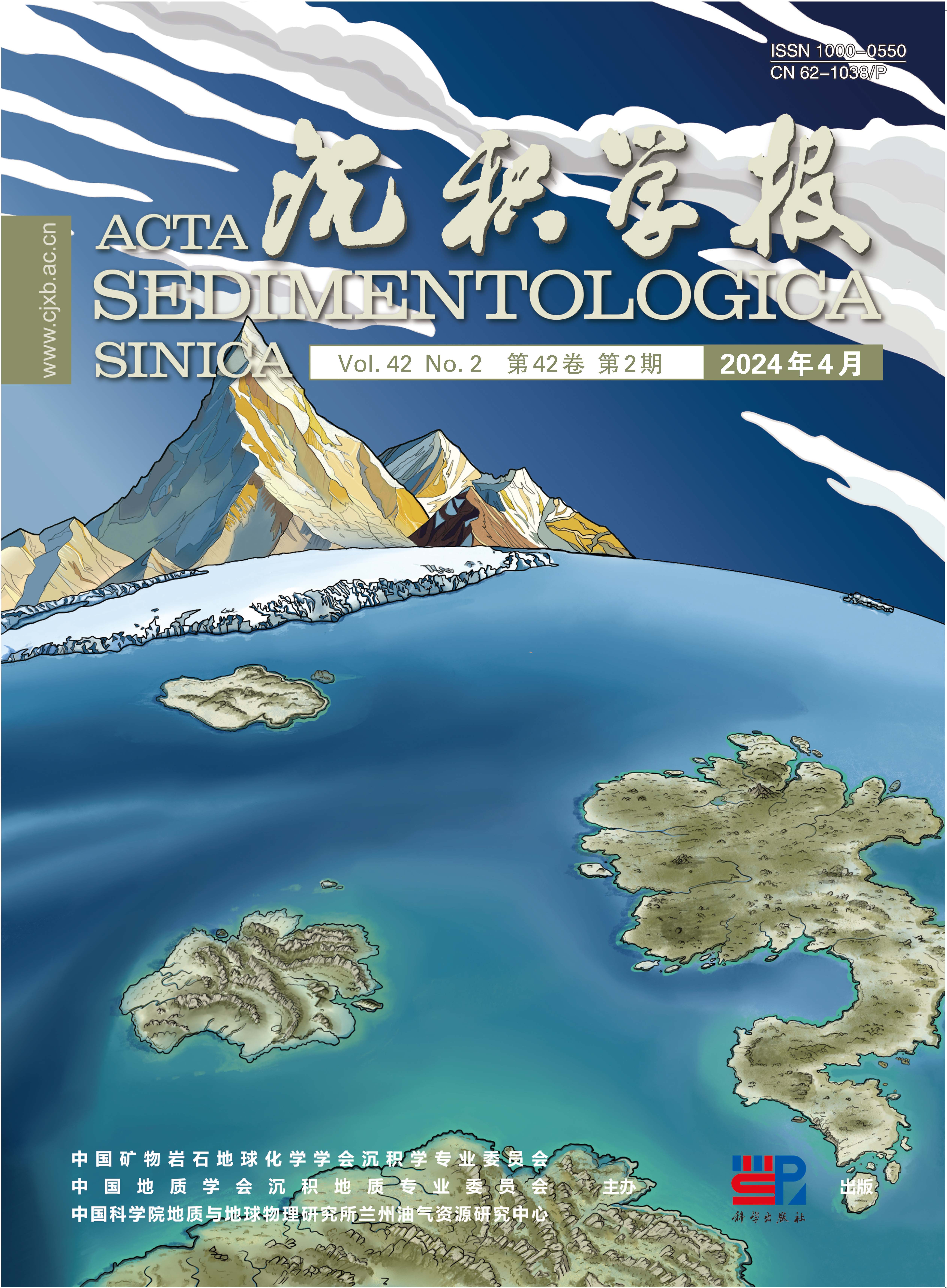


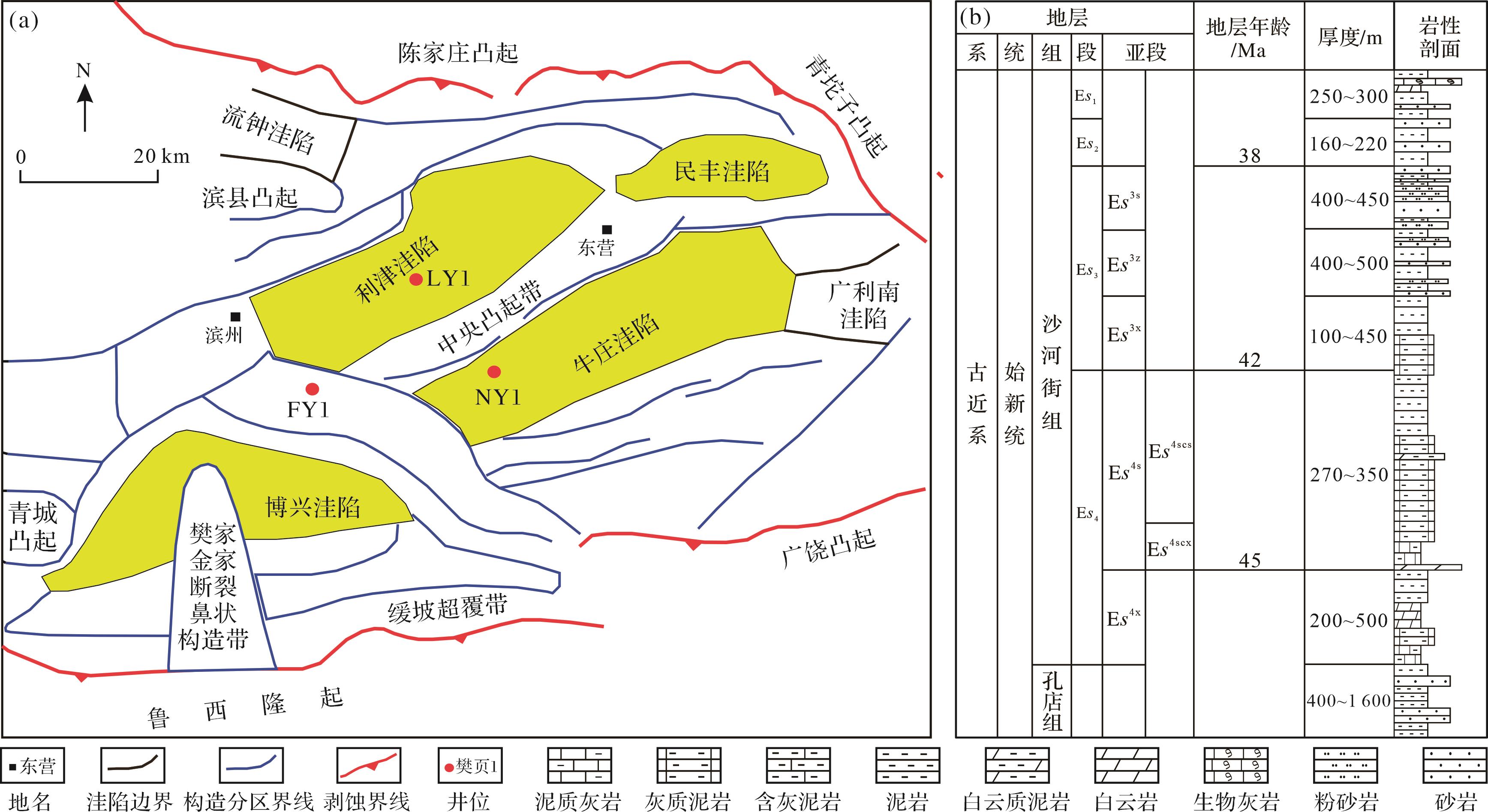










 DownLoad:
DownLoad:

